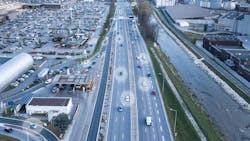In or On? LiDAR Positioning in Cars Explained
What you’ll learn:
- Why LiDAR placement is essential for developing safe self-driving cars.
- How automakers need to incorporate LiDAR placement into the design phase of vehicle development.
LiDAR is a three-dimensional sensor that can be used in highly automated and autonomous vehicles. A LiDAR can “see” and internalize its surroundings during both day and night—even without light. Its ability to measure and know the exact distance to each object, with pinpoint accuracy, in almost every weather condition, is a great advantage in advanced driver-assistance systems (ADAS), specifically over cameras and radars. The latter have been found to be insufficient in more advanced autonomous vehicles.
When determining positioning for a vehicle, the LiDAR can either be forward-looking, rear-looking, or positioned on the side (Fig. 1). If placed in the front of a car or any other vehicle, the primary purpose of the LiDAR is to “look forward” and detect any other vehicle types or obstructions.
Whether on a highway or inside a city, LiDAR can interpret cars, trucks, buses, and two-wheelers (motorbikes, bicycles or scooters), as well as pedestrians and objects such as tires, cones, fallen-down motorbikes, pallets, guard rails, and various other types of debris.
Understanding where to place the LiDAR is crucial in helping improve detection and avoiding a crash with obstacles, ensuring driver and pedestrian safety.
Considerations for LiDAR Installation
Vehicles have an expected lifetime of 10 to 15 years, so installing a LiDAR system involves carefully considering a host of factors from the very start of design. The durability of the LiDAR, a proper heating system for icy and cold weather, a system to detect blockage by insects or dirt, a cleaning system with water or air, and potential damage by stones or pebbles are just a few of many issues that automakers must grapple with when deciding where to put the LiDAR.
LiDAR placement has three main options: Inside the front grille of the car, behind the front windshield, or on the roof. Each of these positions has pros and cons, as outlined below.
1. LiDAR in the front grille of the car
The significant advantage of this location is that the LiDAR is hidden or almost hidden from view (Fig. 2). Thus, it’s a more aesthetically pleasing option. This position provides good airflow, which means that in most cases, there’s no need for a cooling system, even on the hottest of days. One downside of grille installation is that such low positioning might be challenging for LiDAR to detect lane markings very far down the road.
2. Behind the windshield installation
This position doesn’t require its own heating system and protects many of the LiDAR’s components, helping to shield against issues like stones coming up from the road that can cause serious damage. However, the inside of a car can reach very high temperatures and might require an air conditioner to cool it down. This draws on potentially limited power resources that may drain the battery, which is incredibly challenging for EVs.
Furthermore, the materials used in the front windshield, plus the angle and level of reflectivity of the front window of the respective vehicles, must be part of production considerations. All of these factors could impact the ability of the LiDAR to function well and potentially lead to deterioration of the images being received.
3. Roof-mounted LiDAR systems
Many automakers have integrated LiDAR systems onto the car’s roof; some very sleek-looking designs are already on the road. The importance of the aesthetic aspect of these designs can’t be understated, as the LiDAR can’t afford to look like an afterthought. Considerations with on-the-roof LiDAR systems include keeping it cool in hot summers with add-ons like passive or active cooling systems that require additional costs and materials.
Addressing Acoustic Concerns with LiDAR Placement
Determining the optimal placement of LiDAR sensors in vehicles also requires carefully weighing acoustic factors. Excessive noise from LiDAR operation inside the cabin can detract from ride quality and exceed allowable sound levels. Strategic sensor positioning on the exterior can help distance noise sources from passengers, thus lowering noise levels to a minimum.
Another possible solution is isolating LiDAR components with sound-dampening enclosures and shock absorbers, which inhibit reverberation and structure-borne noise. Active noise-cancellation technologies leverage destructive interference to suppress unwanted sounds. Furthermore, damping materials like rubber gaskets and foam inserts applied around the sensor housing can reduce noise vibration and high frequencies.
Challenges in Optimizing LiDAR Positioning
Optimally positioning LiDAR sensors in an automobile is a complex endeavor requiring a holistic analysis from the design through production phases. Engineers must evaluate mounting locations that enable wide environmental visibility while minimizing occlusion, dirt accumulation, and sensor confusion from multipath reflections.
Aesthetic and styling factors also influence placement to maintain visually appealing vehicle designs, as well as acoustic considerations, which are necessary to mitigate noise intrusion into the cabin. Moreover, accessibility for calibration and cleaning must be ensured, in addition to durability testing, to verify that sensors and mounts can withstand vibration, shocks, weather, and debris impacts during real-world driving conditions.
By comprehensively assessing these practical factors, automakers can derive mounting configurations that maximize LiDAR sensor effectiveness, safety, and longevity while meeting performance targets and production costs.
About the Author

Elad Hofstetter
Chief Business Office, Innoviz
Elad Hofstetter has a vast experience in the multidisciplinary fields of automotive and consumer electronics. He has over 15 years of experience in R&D, product management, and project management positions, delivering complex solutions, among others, in the bio-sensing and pharmaceutical industries. Since 2018, Elad has been deeply involved in the technical and commercial offerings of the world's leading automotive OEMs.
Prior to his role at Innoviz Technologies, Elad worked at LifeBEAM Technologies, where he held various roles, including project, production, and engineering management. Earlier on, he held production and QA positions at Teva Pharmaceutical Industries. Elad has a BSc and an MSc in Biomedical Engineering from Tel-Aviv University, Israel.


